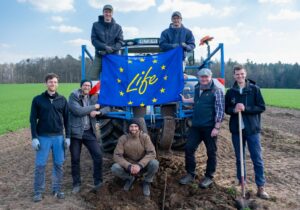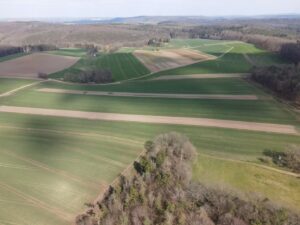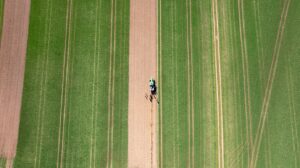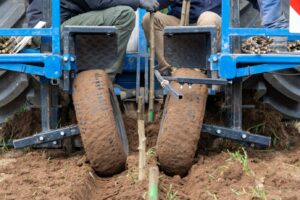In Germany, modern agroforestry systems can only be recorded in the farmland register since 2023. The potential of agroforestry, especially in times of climate change with extreme weather events such as drought and heavy rainfall, is enormous. It is crucial for the agricultural sector to maintain the productive capacity of farmland. However, knowledge about agroforestry is still very limited, especially in practice and training. For this reason, several partners have come together in two projects to jointly establish a demonstration and experimental site for agroforestry at the Hofgut Neumühle educational and experimental centre for livestock farming.
As part of the EU-LIFE project ZENAPA, led by the Institute for Applied Material Flow Management (IfaS), an agroforestry system with approx. 2 ha of trees was planted on 26 ha on 2nd and 3rd April 2025. This is the result of a cooperation project between the Hunsrück-Hochwald National Park and the Hofgut Neumühle educational and experimental centre for livestock farming. The planting was carried out by the company Lignovis GmbH.
The planning and expert assistance for the planting was realised by the FNR project AGROfloW at IfaS (AFaktive sibling project) in coordination with all project partners involved. This lays the foundation for analysing the agroforestry system beyond the ZENAPA timeframe and researching it in a practical context.
As a result, the agroforestry system with 3082 trees is a multi-utilisation system tailored to the equipment and requirements of the experimental centre with a clear research and educational mission. On the one hand, it provides ecosystem services, produces raw materials and benefits biodiversity. On the other hand, the system serves as an illustrative and educational object for the educational and experimental centre. In fact, it can show future generations of farmers the advantages and requirements of such systems for maintaining and securing yields on arable land.
The ecosystem services provided by the trees, such as protection against wind, against surface water run-off during heavy rainfall and against the risk of erosion resulting from these factors, help to preserve the site, which is located in a low mountain position Five different hybrid poplar species are grown on the production-integrated agroforestry area to produce energy wood for the biomass heating system being built on the farm, as well as nine different high-quality deciduous trees. These have been planted for future generations and were selected considering native species and possible climatic changes in the future. The planted value wood species include Turkish hazel (Corylus colurna), sycamore maple (Acer pseudoplatanus), whitebeam (Sorbus aria), wild service tree (Sorbus torminalis), downy oak (Quercus pubescens), sessile oak (Quercus petraea), wild cherry (Prunus avium), small-leaved lime (Tilia cordata) and Turkey oak (Quercus cerris).
The trees, as well as the area around them, offer an increase in biodiversity and perennial flowering. Finally, the system is to be equipped with sensors and researched as part of AGROfloW and subsequent projects in order to monitor long-term effects and – on this basis – to better plan future systems.
©Photos: IfaS





